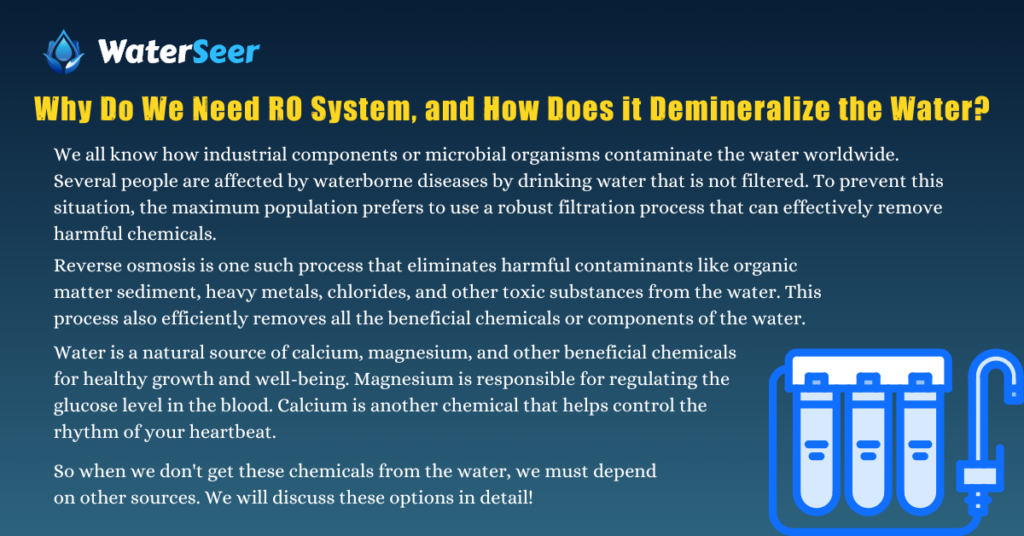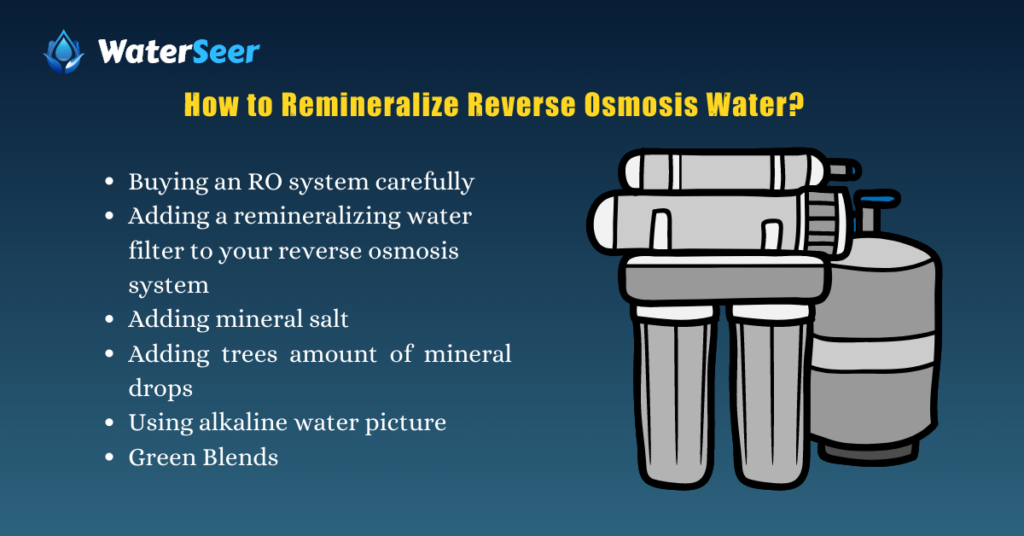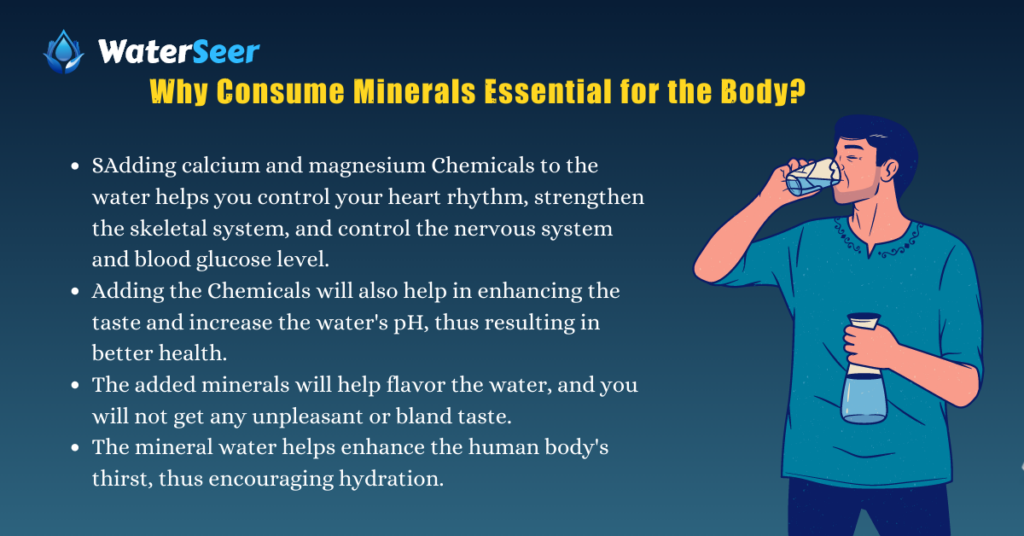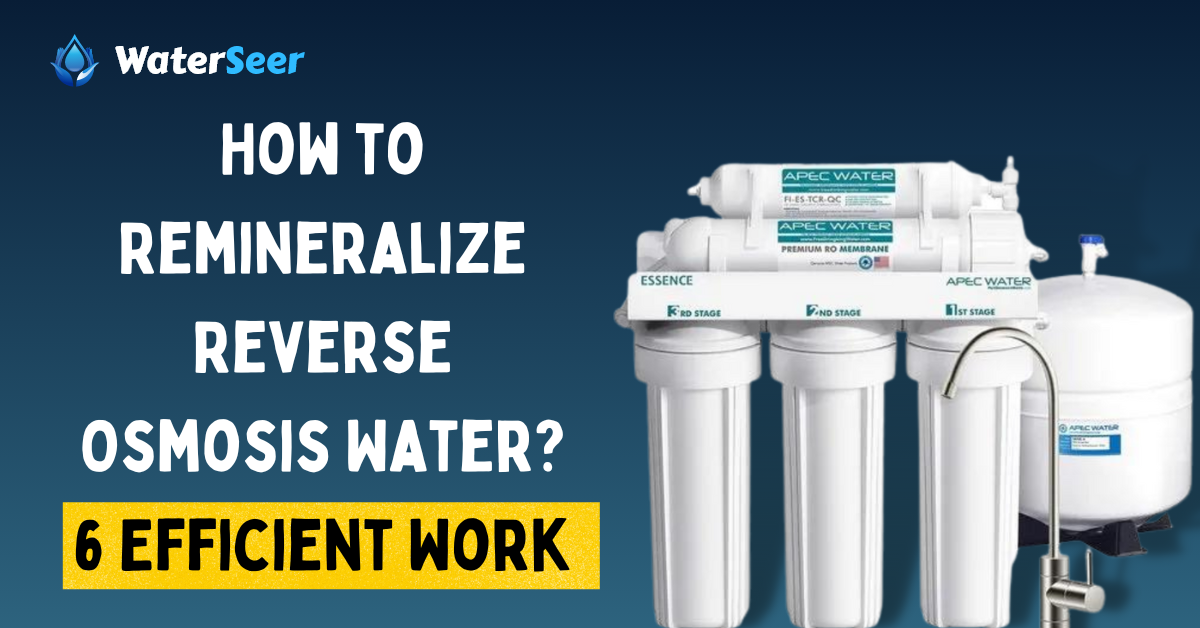RO system, or reverse osmosis system, is considered one of the most advanced technology to filter water effectively. It not only helps remove most contaminants by using a semi-permeable membrane but also enhances the taste of the water.
RO’s main objective is to remove harmful contaminants. Still, it also removes the chemicals like calcium or magnesium, which are beneficiary for human growth and development.
This can not go well with some customers because water is the natural source of nutrients required for a healthy body. And when you don’t give minerals, the body suffers from mineral deficiency.
To solve this issue, remineralization of water is a widespread practice. This article will discuss how you can effectively solve remineralizing the water by providing an in-depth explanation. So make sure that you read this article carefully!
Why Do We Need RO System, And How Does it Demineralize the Water?

We all know how industrial components or microbial organisms contaminate the water worldwide. Several people are affected by waterborne diseases by drinking water that is not filtered. To prevent this situation, the maximum population prefers to use a robust filtration process that can effectively remove harmful chemicals.
Reverse osmosis is one such process that eliminates harmful contaminants like organic matter sediment, heavy metals, chlorides, and other toxic substances from the water. This process also efficiently removes all the beneficial chemicals or components of the water.
Water is a natural source of calcium, magnesium, and other beneficial chemicals for healthy growth and well-being. Magnesium is responsible for regulating the glucose level in the blood. Calcium is another chemical that helps control the rhythm of your heartbeat.
So when we don’t get these chemicals from the water, we must depend on other sources. We will discuss these options in detail!
What Minerals Does Reverse Osmosis Remove?
Reverse osmosis removes around 90% of the total chemicals present in the water. It removes the harmful and beneficial chemicals in the water responsible for providing nutrition to the human body.
Most of the time, the municipality department of your area adds a very high concentration of chlorine to make the water free from microorganisms. The excessive chlorine content in the water can impact your health, which is why reverse osmosis comes into action.
There is a high chance that excessive consumption of reverse osmosis water can result in mineral deficiency. Besides chlorine, it also removes a high volume of calcium, lead, fluoride, iron, magnesium, and salt. Complete removal of calcium and magnesium can also impact human health, as they are responsible for the proper growth and development of the human body.
Also Read: The 5 Best Sediment Filters for Well Water (Our Top Picks)
How to Remineralize Reverse Osmosis Water?

According to the Centre For Disease Control, one in two children under five worldwide suffers from mineral deficiency. The food we intake or the water we depend on is not a healthy source of consuming all the beneficiary minerals. The alarming statistics are increasing day by day all around the world because of the increasing population and pollution.
The population because the resources are limited, which limits water access resulting in a water shortage in many parts of the world. The remaining water, or the drinkable water, gets polluted by industrial waste, microbial organisms, etc., making drinking unhealthy. In this situation, checking the minerals we consume to maintain good health has become essential.
It is always foolish to believe in a misconception that eating healthy or drinking healthy water means you will not suffer from mineral deficiency. Using the RO system can be your biggest enemy! We have already discussed “how,” and NOW we will discuss the solutions in detail.
To save you time, here is a list of all the points that we will discuss in detail:
- Buying an RO system carefully
- Adding a remineralizing water filter to your reverse osmosis system
- Adding mineral salt
- Adding trees amount of mineral drops
- Using alkaline water picture
- Green Blends
1. Buying an RO System Carefully
We will always recommend that whenever you buy a reverse osmosis system, you should research a lot about them. Not only the functioning and performance but also the principles it works into.
To save you from all the hustle and hardships, we have already provided a detailed article about the best RO system available by testing them at our facility. So make sure you remember to check that out!
Most RO system works in five primary stages. First are the pre-filter, semi-permeable membrane, and post-filter. Few reverse osmosis systems have a post-activated carbon filter that helps remineralize the water. We recommend you research the systems or equipment before buying.
2. Adding a Remineralizing Water Filter to Your Reverse Osmosis System
The second on the list is adding a remineralizing water filter to your reverse osmosis system. As mentioned above, only a few reverse osmosis systems in the market have a post-activated carbon filter.
But if you’ve already bought it and cannot return it to the manufacturer, adding a remineralizing water filter can be the best option. But reputable brands’ post-filter cartridges will be costly, like 80$. So, make sure to research and then buy the product.
These are widely available in the market by the name of remin filters. To add the filter to the reverse osmosis system, you must install it in your main water line after the equipment has purified the water. So whenever you open the tap to get the water, the water is already remineralized by the remin filter.
3. Adding Mineral Salt
The third on the list is adding mineral salt. You can add a natural source to your systems, such as rock salt or Himalayan salt. Such types of salt have 84 trace minerals in just a pinch and are highly beneficial for maintaining an individual’s health.
All of your problems can be solved with just A Pinch of salt, which is highly affordable, but make sure that you don’t add it in excess because a high sodium content can result in equipment problems.
4. Adding a Trace Amount of Mineral Drops
Electrolyte blends are another name for trace mineral drops. If you’re using this option, there’s good news for you because you can use this option at any part of the reverse osmosis equipment. A few mineral drops generally contain magnesium calcium, magnesium iron, Selenium, and copper as the main component, which is highly beneficial for human growth and development.
5. Using an Alkaline Water Pitcher
The beneficiary component of the water also depends on the pH level of the water. When the reverse osmosis system removes the chemical from the water, its pH decreases, so to overcome this issue, you can use a simple alkaline pitcher to increase its PH. This will enhance the number of minerals in the water, thus providing benefits.
6. Green Blends
If you are a person who highly enjoys plant products, then this solution is for you! To overcome your issue, you can use Green blends which consist of all the minerals extracted from plants and vegetables. They have a very balanced set of highly beneficial minerals, but they can alter the taste of the water. This is a short-term solution.
The above-discussed options are the best options that can be used to remineralize the water. It is essential to add calcium and magnesium to your diet or water.
Calcium constitutes around 2% of the body’s weight, and the deficiency can lead to several other improper functioning like blood clotting, hormone regulation, enzyme regulation, nervous system, and muscular contraction.
Magnesium is another chemical responsible for playing a vital role in maintaining an individual’s health because it takes part in around 300 biochemical reactions in your body.
Any magnesium deficiency can influence this 300-chemical reaction, adversely impacting your body. You will feel continuous numbness, irregular rhythm of your heart, and cramps in your body if you suffer from magnesium deficiency.
Why Consume Minerals Essential for the Body?

As mentioned in the above sections, minerals play a vital role in strengthening bones and teeth. Apart from this, they also help maintain the osmolarity outside and inside the cell, which is very important for cell life. They also help in providing energy by metabolizing the food and several other advantages. A few of them are listed down below:
- Adding calcium and magnesium Chemicals to the water helps you control your heart rhythm, strengthen the skeletal system, and control the nervous system and blood glucose level.
- Adding the Chemicals will also help in enhancing the taste and increase the water’s pH, thus resulting in better health.
- The added minerals will help flavor the water, and you will not get any unpleasant or bland taste.
- The mineral water helps enhance the human body’s thirst, thus encouraging hydration.
Benefits of Adding Minerals to Reverse Osmosis Water
Remineralizing or adding minerals to reverse osmosis water has many advantages and benefits. As mentioned earlier, reverse osmosis water does not contain many minerals necessary for human growth and development.
First, the remineralization process of all the essential minerals leads to proper growth and functioning of the human body. It not only helps you to meet the demands of your body but also helps you to live a healthy life. As mentioned earlier, reverse osmosis water does not contain many minerals necessary for human growth and development.
Remineralizing water can add flavor to water by increasing water pH, resulting in better heart rhythm, strengthening the skeletal system, and controlling the blood glucose level and the nervous system.
The remineralization technique also enhances the thirst episode of a person, due to which a person consumes a large amount of water necessary for hydrating the body. We all know that excess dehydration can lead to other symptoms like nausea, lethargy, headache, etc.
Frequently Asked Questions
Why is remineralizing very important?
Remineralizing the reverse osmosis water is very important because the process removes calcium and magnesium chemicals from the water, along with the harmful chemicals.
Calcium and magnesium are vital in maintaining the skeletal system, heart rhythm, nervous system, etc. If you are not in-taking these Chemicals, your body can suffer from mineral deficiency.
Is there any other way of protecting the body from mineral deficiency?
Yes, there are different ways to protect the body from mineral deficiency. Remineralizing water by any option mentioned above or changing the diet (including the beneficiary minerals and nutrients) are the two widely accepted solutions to your problem.
Does the reverse osmosis water consist of any minerals?
Yes, reverse osmosis equipment generally eliminates around 90% of the impurities, but some chemicals may be in trace amounts. A few reverse osmosis equipment also has a pre-activated carbon filter which enhances or adds minerals to the water.
What are the symptoms that may occur if my body is suffering from mineral deficiency?
There may be several symptoms that will help you to notice the mineral deficiency in your body. For example, you will suffer from continuous headaches, muscular muscle pain, irregular heartbeat, weakness, and fatigue. If you suffer from the symptoms for a very long time, it can impact kidney functions, bone mass, and hormone secretion.
Conclusion
The RO equipment removes most beneficiary chemicals, like calcium and magnesium, from the water during filtration. Calcium and magnesium are essential for the health of an individual, and that is why it becomes necessary to Remineralize Reverse Osmosis Water.
In this article, we have discussed many options that can help remineralize the water, thus enhancing the water quality. To do so, several options include fixing a remineralizing filter, adding Himalayan salt, a trace amount of mineral drops, etc. We hope this article helped you conclude your decision to choose the best option.

